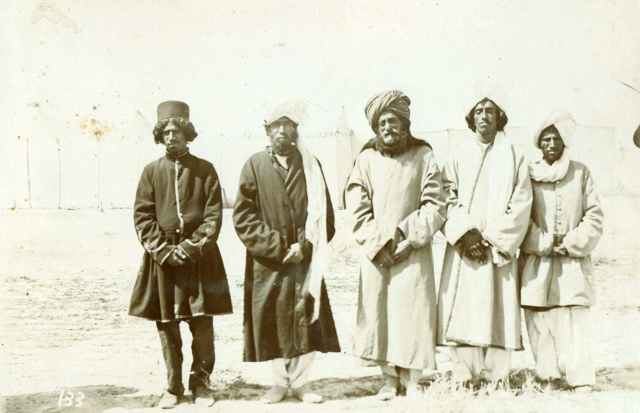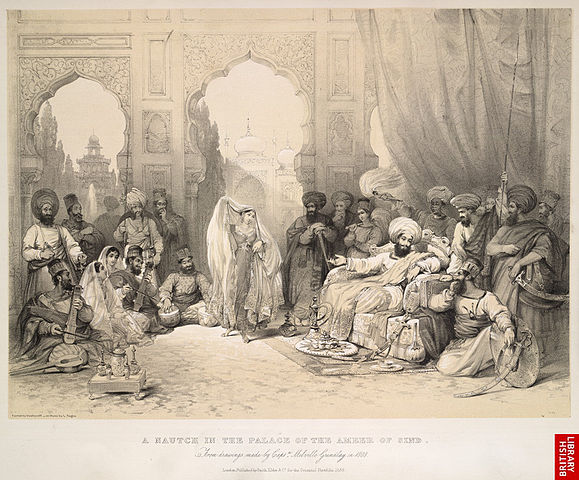
| BALOCH The Baloch or Baluch (romanized: Balòc) are an Iranian people who live mainly in the Balochistan region, located at the south-eastern most edge of the Iranian plateau, encompassing the countries of Pakistan, Iran and Afghanistan. There are also Baloch diaspora communities in neighbouring regions, including in India, Turkmenistan and the Arabian Peninsula.
The Baloch people mainly speak Balochi, a Northwestern Iranian language, despite their contrasting location on the southeastern side of the Persosphere. The majority of Baloch reside within Pakistan. About 50% of the total ethnic Baloch population live in the Pakistani province of Balochistan, while 40% are settled in Sindh and a significant albeit smaller number reside in Pakistani Punjab. They make up nearly 3.6% of Pakistan's total population, and around 2% of the populations of both Iran and Afghanistan.
Etymology
:
•
Rawlinson (1873) believed that it is derived from the name of the
Babylonian king and god Belus.
History :
Palace of the Baloch Emir of Sindh in 1808 According to Baloch lore, their ancestors hail from Aleppo in what is now Syria. They claim to be descendants of Ameer Hamza, uncle of the Islamic prophet Muhammad, who settled in Halab (present-day Aleppo). After the fight against second Umayyad Caliph Yazid I at Karbala (in which Ameer Hamza's descendants supported and fought alongside Husayn ibn Ali) in 680, descendants of Ameer Hamza migrated to east or southeast of the central Caspian region, specially toward Sistan, Iran, remaining there for nearly 500 years until they fled to the Makran region following a deception against the Sistan leader Badr-ud-Din. [citation needed]
Dayaram Gidumal writes that a Balochi legend is backed up by the medieval Qarmatians. The fact that the Karmatians were ethnic Baluchis is also confirmed by the Persian historian in the 16th century Muhammad Qasim Ferishta. According to another historian Ali Sher Kanei, the author of Tuhfatul Kiram, in his history written in 1774 A.D, he believes that only the Rind tribe from Jalal Khan, a descendant of Muhammad ibn Harun, nicknamed Makurani, is a direct descendant of Hamza. Based on an analysis of the linguistic connections of the Balochi language, which is one of the Western Iranian languages, the original homeland of the Balochi tribes was likely to the east or southeast of the central Caspian region. The Baloch began migrating towards the east in the late Sasanian period. The cause of the migration is unknown but may have been as a result of the generally unstable conditions in the Caspian area. The migrations occurred over several centuries.
By
the 9th century, Arab writers refer to the Baloch as living in the
area between Kerman, Khorasan, Sistan, and Makran in what is now
eastern Iran. Although they kept flocks of sheep, the Baloches also
engaged in plundering travelers on the desert routes. This brought
them into conflict with the Buyids, and later the Ghaznavids and
the Seljuqs. Adud al-Dawla of the Buyid dynasty launched a punitive
campaign against them and defeated them in 971–972.
Baloch culture :
Cultural man of Bugti tribe Gold ornaments such as necklaces and bracelets are an important aspect of Baloch women's traditions and among their most favoured items of jewellery are dorr, heavy earrings that are fastened to the head with gold chains so that the heavy weight will not cause harm to the ears. They usually wear a gold brooch (tasni) that is made by local jewellers in different shapes and sizes and is used to fasten the two parts of the dress together over the chest. In ancient times, especially during the pre-Islamic era, it was common for Baloch women to perform dances and sing folk songs at different events. The tradition of a Baloch mother singing lullabies to her children has played an important role in the transfer of knowledge from generation to generation since ancient times. Apart from the dressing style of the Baloch, indigenous and local traditions and customs are also of great importance to the Baloch.
Baloch Culture Day is celebrated by the Balochi people annually on 2 March with festivities to celebrate their rich culture and history.
Baloch tribes :
Tradition :
Traditionally, Jalal Khan was the ruler and founder of the first Balochi confederacy in 12th century. (He may be the same as Jalal ad-Din Mingburnu the last ruler of the Khwarezmian Empire.) Jalal Khan left four sons – Rind Khan, Lashar Khan, Hoth Khan, Kora Khan and a daughter, Bibi Jato, who married his nephew Murad.
Divisions
: Five Baloch tribes derive their eponymous names from Khan's children. Many, if not all, Baloch tribes can be categorized as either Rind or Lashari based on their actual descent or historical tribal allegiances that developed into cross-generational relationships. [citation needed] This basic division was accentuated by a war lasting 30 years between the Rind and Lashari tribes in the 15th century.
Pakistan
:
Nawab Akbar Khan Bugti led the Bugti as Tumandar until his death in 2006. Talal Akbar Bugti was the tribal leader and President of the Jamhoori Watan Party from 2006 until his death in 2015.
There are 98,000 Marri based in Kohlo district, who further divide themselves into Gazni Marri, Bejarani Marri, and Zarkon Marri. Hyrbyair Marri has led the Balochistan Liberation Army since his brother's death in 2007.
Tribalism
:
Baloch tribes are markedly less egalitarian, as are the Pashtun tribes.
Genetics
:
Religion :
The majority of the Baloch people in Pakistan are Sunni Muslims, with 64.78% belonging to the Deobandi movement, 33.38% to the Barelvi movement, and 1.25% to the Ahl-i Hadith movement. Shia Muslims comprise 0.59% of Balochs. 800,000 Pakistani Balochis are estimated to follow the Zikri sect. Although Baloch leaders, backed by traditional scholarship, have held that the Baloch people are secular, Christine Fair and Ali Hamza found during their recent (2017) empirical study that, when it comes to Islamism, "contrary to the conventional wisdom, Baloch are generally indistinguishable from other Pakistanis in Balochistan or the rest of Pakistan". There are virtually no statistically significant or substantive differences between Balochi Muslims and other Muslims in Pakistan in terms of religiosity, support for a sharia-compliant Pakistan state, liberating Muslims from oppression, etc.
A small number of Balochs are non-Muslims, particularly in the Bugti clan which has Hindu and Sikh members. There are a few Hindus in the Bugti, Bezenjo, Marri, Rind and other Baloch tribes. The Bhagnaris are a Hindu Baloch community living in India who trace their origin to southern Balochistan but migrated to India during the Partition.
Source :
https://en.wikipedia.org/wiki/ |





_(14782067294).jpg)